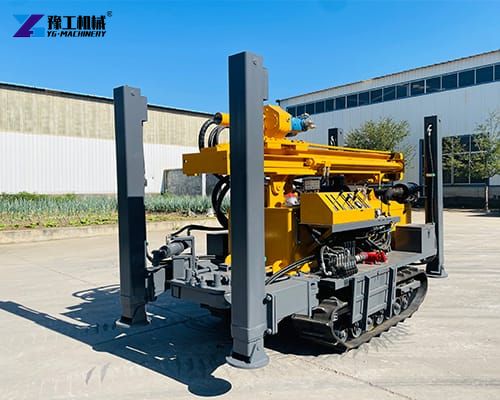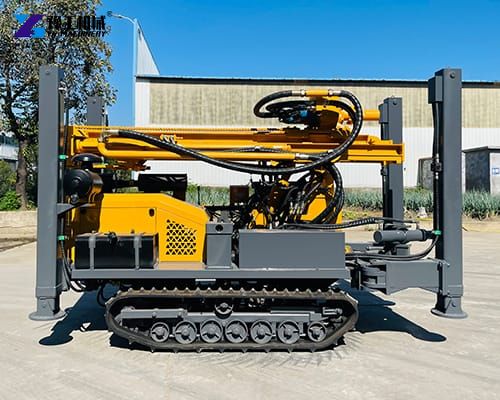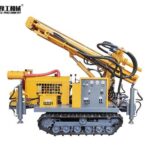Drilling rig for water, often referred to as a water well drilling rig, is an essential piece of machinery designed to bore holes into the ground for accessing underground water sources. It plays a vital role in agricultural irrigation, industrial water supply, and domestic use, particularly in regions where groundwater is the main source of fresh water. Water drilling rigs are indispensable for developing sustainable water sources in remote and arid regions. With technological advancements, modern rigs have become more efficient, environmentally friendly, and capable of drilling deeper and faster.


Parameter of the Drilling Rig for Water
| Model | YG180 |
| Weight | 4.5T |
| The hole diameter | 140-254mm |
| Drill depth | 180m |
| One-time advance length | 3.3m |
| Walking speed | 2.5km/h |
| Gradeability | Max. 30 |
| Equipped capacitor | 55kw |
| Working air pressure | 1.7-2.5Mpa |
| Air consumption | 17-31m³/min |
| Swing speed | 45-70rpm |
| High leg stroke | 1.4m |
| Drill pipe diameter | φ76mm φ89mm |
| Drill pipe length | 1.5m, 2.0m, 3.0m |
| Rig lifting force | 12T |
| Rapid rise speed | 20m/min |
| Fast feeding speed | 40m/min |
| Width of loading | 2.4m |
| Swing torque | 3200-4600N.m |
| Dimensions | 3950*1630*2250mm |
| The penetration efficiency | 10-35m/h |
| The engine brand | quanchai |
Types of Drilling Rig for Water
Water well drilling rigs come in various configurations tailored to specific environments and operational needs. Common types include:
- Truck-Mounted Rigs: Portable and efficient, ideal for remote locations.
- Crawler Rigs: Equipped with tracked bases for stability on uneven terrain.
- Trailer Rigs: Transportable units suitable for small-scale projects.
- Portable Rigs: Lightweight models for shallow wells or mobile operations.


Features of Water Well Drilling Rig
A high-quality drilling rig for water is characterized by several distinctive features that enhance performance, durability, and ease of operation. Common features include:
- Powerful Engine System: Most rigs are powered by diesel or hydraulic systems capable of delivering consistent torque and speed.
- Rotary Head Mechanism: The rotary head ensures stable and precise drilling, even in tough geological conditions.
- Strong Drilling Frame: The structure is typically made of durable materials to withstand vibration, pressure, and heavy-duty operation.
- Compact Design for Mobility: Portable rigs are designed for quick setup and easy transportation, ideal for remote or small-scale projects.
Applications of Water Well Drilling Equipment
While primarily used for drinking water, a drilling rig for water has diverse applications:
- Residential and Municipal Water Supply: Drilling deep, reliable wells for homes, subdivisions, and small towns without access to central water infrastructure.
- Agricultural Irrigation: Creating high yield wells to support large scale farming and ensure drought resilience.
- Industrial and Construction Use: Providing a steady water source for industrial processes or construction site needs.
- Geothermal and Cathodic Protection: The same rigs are often used to drill boreholes for installing geothermal heating/cooling systems or sacrificial anodes for corrosion protection.


Working Principle of the Water Well Drilling Machine
The basic working principle of a drilling rig for water involves rotational and percussive actions to penetrate the ground. The process generally includes the following steps:
- Site Preparation – The rig is positioned and leveled on the drilling site.
- Bit Rotation and Feed – The rotary head spins the drill bit while downward pressure allows it to cut through the earth.
- Mud Circulation – Drilling fluid is pumped down through the drill pipe to cool the bit and lift cuttings to the surface.
- Casing Installation – As drilling progresses, casing pipes are inserted to prevent borehole collapse.
- Well Completion – Once the desired depth is reached, the borehole is cleaned, and the well is developed for water extraction.
How to Choose the Right Drilling Rig for Water?
Selecting the appropriate drilling rig involves careful evaluation of several factors:
Drilling Depth and Diameter Requirements: Ensure the rig can reach the desired aquifer depth.
Geological Conditions: Match the rig type with soil hardness and rock composition.
Mobility Needs: Choose portable rigs for remote sites or truck-mounted ones for extensive drilling.
Power Source: Diesel-powered rigs offer strength, while electric models are cleaner and quieter.
Maintenance Tips for Drilling Rigs for Water
- Lubrication: Regularly lubricate moving parts to prevent wear and overheating.
- Inspection of Hydraulic Lines: Check for leaks and replace worn-out hoses or seals.
- Cleaning the Mud Pump System: Prevent blockages and corrosion by flushing the system after use.
- Checking the Drill Bit and Rods: Replace dull or damaged bits promptly.
- Monitoring Engine and Power System: Keep filters clean and maintain optimal oil levels.
- Storage and Protection: Store the rig in a dry, covered area when not in use to avoid rust and deterioration.


